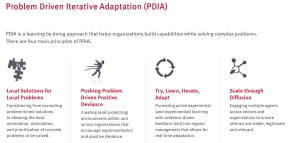written by Matt Andrews
In 2010, Lant Pritchett, Michael Woolcock and I started writing about PDIA (problem driven iterative adaptation) as a potential approach to do development differently.
We had been observing that many development initiatives were not yielding anticipated results, and more importantly not building any kind of capability in developing country governments.
We managed to describe the situation by referring to ‘capability traps’ like isomorphic mimicry and premature load bearing—‘successful strategies for continued failure’ that characterized much of the development landscape. We were able, further, to identify that the development community was especially susceptible to fall into these traps because projects tended to be solution-driven, linearly structured, and top-down, expert dominated.
Given this ‘observe, describe and identify’ research, we posited that an alternative approach might yield different results. Hence we came up with the principles of PDIA—start with problems, iterate to experiment with many ideas and learn the way towards contextually fitted solutions, in large and diffused groups.

As early as 2011 we had people from all over the developing community asking ‘how do we do PDIA?’ and even advising that we start a consulting operation ‘to do PDIA.’ This was all rather unsettling to us, as all we had done to that point was observe and describe. We could not prescribe something that was just an observed set of ideas.
To move from description to prescription, we had to develop a research program that was conducted in the real world, where we could experiment with ways to do PDIA. We have since engaged in many such initiatives, testing ideas both big and small:
- Can solution-driven organizations really have effective conversations about problems?
- Is it possible to come up with new ideas and not get stuck on old solutions?
- Will governments authorize experimentation when they don’t have a promise of results?
- Do development organizations that lend money to governments have an appetite for the kind of gritty work required under PDIA?
- Are local entities and people in developing countries willing and able to do the work required to ‘find and fit’ their own solutions?
And more questions. Many more questions.
Our new PDIA in Practice Series (PiPS) describes how our action research agenda grew around these questions, and how the PDIA process we work with today emerged through this agenda. Today we release our second ‘PiPS’ that tells the story of one of our early engagements helping a World Bank and Government team in Mozambique develop a new kind of public financial management lending operation. The story goes from 2010 to the current period, even though our engagement ended in 2012. Through this experience, we learned that problems can be major instigators of action, that development organizations like the World Bank can do PDIA (even if by another name) and empower local people through the problem driven, iterative, approach, and we learned that the basics of PDIA works to help people in their own contexts identify and tackle their own problems and mobilize ideas that lead to real solutions, that they own and that they are capable of replicating.
Most importantly, perhaps, we learned that there are agents in organizations like the World Bank and the Government of Mozambique who see the value of PDIA-like processes and are willing to fight for these kinds of processes in their contexts. This inspires us to do more action research, and to hone the methods and approaches implicit in PDIA to be more useful than ever.
You can download PiPS 2 and also listen to the accompanying podcast.
